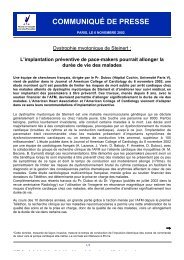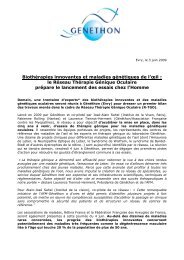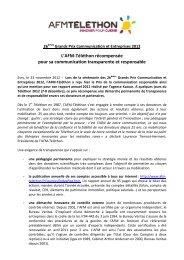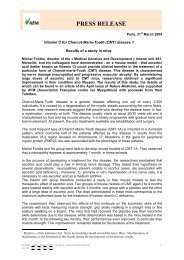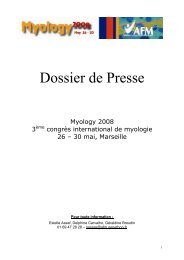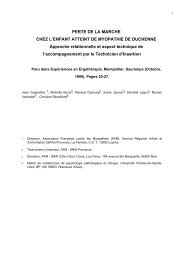210x270 Myoline N° 1 - Institut de Myologie
210x270 Myoline N° 1 - Institut de Myologie
210x270 Myoline N° 1 - Institut de Myologie
You also want an ePaper? Increase the reach of your titles
YUMPU automatically turns print PDFs into web optimized ePapers that Google loves.
MISE AU POINT<br />
Résumé<br />
La MFM est une mesure générique évaluant le<br />
retentissement <strong>de</strong> la faiblesse musculaire sur la<br />
posture (tenue <strong>de</strong> tête, station assise, position<br />
<strong>de</strong>bout) et le mouvement (tête, tronc, membres<br />
supérieurs et inférieurs) dans les maladies neuromusculaires.<br />
La MFM est utilisable pour les patients<br />
ayant ou non conservé la marche quelle que soit la<br />
sévérité <strong>de</strong> la maladie. Des exercices précis avec<br />
une position <strong>de</strong> départ définie <strong>de</strong> façon rigoureuse<br />
sont exécutés par le patient sans ai<strong>de</strong> extérieure et<br />
sont cotés <strong>de</strong> 0 (échoué) à 3 (réalisation normale).<br />
Un manuel <strong>de</strong> l’utilisateur décrit les compensations<br />
possibles et la cotation <strong>de</strong> chaque situation. La<br />
version MFM-32, validée <strong>de</strong> 6 à 60 ans et la version<br />
MFM-20, validée <strong>de</strong> 2 à 6 ans sont composées <strong>de</strong><br />
trois dimensions : D1 (station <strong>de</strong>bout et transferts),<br />
D2 (motricité axiale et proximale) et D3 (motricité<br />
distale). Un score total et un score par dimension<br />
sont exprimés en pourcentage. Un site www.mfmnmd.org,<br />
en anglais, espagnol et français, facilite la<br />
diffusion <strong>de</strong>s informations concernant la MFM et son<br />
développement.<br />
Mots clés : mesure - échelle – évaluation - fonction<br />
motrice – maladie neuromusculaire<br />
REFERENCES<br />
Barois A. et al, Bull Acad Natle Méd, 2005,189(6) : 1181-99<br />
Bénaïm C. et al, Rev neurol (Paris), 2010, 166(1) : 49-53<br />
Bérard C. et al, Neuromuscul Disord, 2005, 15(7) : 463-70<br />
Bérard C. et al, Rev Neurol (Paris), 2006, 162(4) : 485?93<br />
Bérard C. et al, Neuromuscul Disord, 2008,18(7) : 593-4<br />
Brooke M. H., Muscle Nerve, 1981, 4(3) : 186-97<br />
De Lattre C. et al, Neuromuscul disord, 2009,19(8-9) : 571<br />
Iannaccone S. T., Arch Neurol, 2002, 59(9) : 1445-50<br />
Iwabe C. et al, Rev Bras Fisioter, 2008, 12(5) : 417-24<br />
Krosschell K. J. et al, Neuromuscul Disord, 2006, 16(7) : 417-26<br />
McDonald C. M. et al, Neuromuscul Disord, 2008, 18(9-10) : 739<br />
Abstract<br />
The MFM is a generic tool measuring the impact<br />
of muscular weakness on posture (head posture,<br />
sitting position, upright position) and motion (head,<br />
trunk, upper and lower limbs) in neuromuscular<br />
patients. The MFM can be used in ambulant and<br />
non-ambulant patients irrespective of disease<br />
severity. Specific movements with a rigorously<br />
<strong>de</strong>fined starting position are carried out by the<br />
patient without any outsi<strong>de</strong> assistance and are<br />
scored from 0 (failed) to 3 (normal). A user’s<br />
manual <strong>de</strong>scribes the possible compensations and<br />
appropriate scoring of each situation. The validated<br />
version MFM-32 for patients from 6 to 60 years old<br />
and the validated version MFM-20 for children from<br />
2 to 6 years old follow 3 dimensions : D1 (upright<br />
position and transfers), D2 (axial and proximal<br />
motricity) and D3 (distal motricity). A global score<br />
and a score for each dimension are expressed<br />
in percentages. A multilingual website (www.<br />
mfm-nmd.org) facilitates dissemination of the<br />
information and <strong>de</strong>velopments related to the MFM.<br />
Keywords : measure - scale - evaluation – motor<br />
function – neuromuscular disease<br />
McDonald C. M. et al, Neuromuscul Disord, 2009, 19(8-9) : 601-2<br />
Main M. et al, Eur J Paediatr Neurol, 2003, 7(4) : 155-9<br />
Mazzone E. S. et al; Neuromuscul Disord, 2009, 19(7) : 458–61.<br />
O'Hagen J. M. et al, Neuromuscul Disord, 2007, 17(9-10) : 693-7<br />
Scott E. et al, Dev Med Child Neurol, 2006, 48(6) : 540-4<br />
Scott O. M. et al, Muscle Nerve,1982, 5(4) : 291-301<br />
Van<strong>de</strong>rvel<strong>de</strong> L. et al, Neuromuscul disord, 2007, 17(6) : 459-69<br />
Vignos P. J. et al, J Am Med Assoc, 1963, 184 : 89-96.<br />
Vuillerot C. et al, J Adol Health, 2010a, 46(1) : 70-6<br />
Vuillerot C. et al, Dev Med Child Neurol, 2010b, 52 : 60-65<br />
Vuillerot C. et al, Neuromuscul disord, 2009, 19(8-9) : 573<br />
34 N°2 AVRIL 2010 Les cahiers <strong>de</strong> myologie




